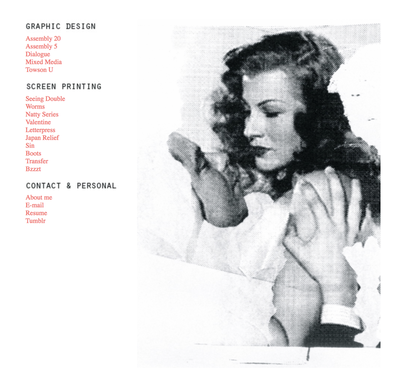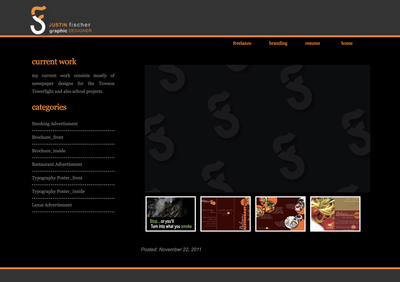Design for the Web I
Towson University, Towson MD (2011-2013)
Course Objectives
Students will become familiar with the concepts, terminology and techniques used in World Wide Web Authoring. Students will also begin to think critically about effective site design, information architecture and interactivity. To do so, students will produce a series of websites, complete development assignments, give critical presentations, and keep up on related readings.
Materials and Texts
You are required to have TWO separate drives for saving two copies of your work throughout the semester.
You are required to update them both as frequently as possible to prevent incidences of lost work due to file corruption, drive breakdown, accidental file overrides and other possible technical disasters that do happen from time to time. I will not excuse any missing projects due to lost file information - part of learning how to design for the web is learning how to work with all problems that arise.
W3 Schools - www.w3schools.com
HTML Dog Tutorials – www.htmldog.com
Web Style Guide – www.webstyleguide.com
Recommended Texts
HTML & XHTML Pocket Reference –Jennifer Niederst Robbins
CSS Pocket Reference – Erica A. Meyer
HTML, XHTML & CSS: Visual Quick Start Guide – Elizabeth Castro
Photoshop CS5 for Windows and Mac: Visual Quick Start Guide – Elaine Weinmann
Dreamweaver CS5 for Windows and Mac: Visual Quick Start Guide – Tom Negrino and Dori Smith
Don't Make Me Think: A common Sense Approach to Web Usability – Steve Krug
Attendance
I want this to be a fun, exciting and challenging experience that is loose in many ways of interpretation, but be warned, I take absences and lateness very seriously - we cannot get into the nuances and minutia of this course without full participation from everyone. If you are ill, please stay home, however, giving me notice of your absence PRIOR to class via email. If you do not let me know prior to class that you will be absent, I will not excuse the absence.
Three unexcused absences will result in a half-letter drop in your grade. Each subsequent unexcused absence will result in another half-letter grade drop. Should you miss a class, you're responsible for keeping abreast of what is due next class, either through this syllabus or contacting a classmate. I do not take responsibility for letting you know what you missed. Ask a classmate. Find a buddy to keep in touch with through out the semester incase you are absent or late and miss information given in class. Again, I don't take responsibility for letting you know what you missed, excused or unexcused.
You are also expected to arrive on time to class – After 10 minutes, I keep a policy of closing the locked door and not allowing students to join class. Late arrivals past ten minutes are considered an absence. Late arrivals are extremely disruptive, disrespectful, and rude. I keep this policy to minimize the disruption for students who have arrived on-time.
If you are any more than ten minutes late or leave class early without prior conversations with me, I will consider that an unexcused absence.
Three late arrivals up to ten minutes will be considered an unexcused absence.
Grading
Homework: 10%
Exams: 15%
Participation: 15%
Presentations: 10%
Websites: 50%
Extensions may be possible with prior conversations with me regarding your situation.
Any project accepted will not receive full credit and will be graded at my discretion.
A Few Important Notes About This Course
Academic Integrity
All class members are to follow the fundamental principles of academic integrity outlined in the Code of Student Rights, Responsibilities, and Con- duct. The policy on Academic Misconduct appears in the code and in the schedule of classes. The basic principle is that students take credit only for the ideas and efforts that are their own. Any act of academic dishonesty will place you in jeopardy of the most severe form of sanction by Towson University expulsion from the university.
Included among dishonest behaviors in an academic setting are cheating (using or attempting to use unauthorized assistance, materials, information, or study aids in an academic exercise), fabrication (falsifying or inventing information in an academic exercise), plagiarism(adopting or reproduction of ideas, words, or statements of another person without appropriate acknowledgment), interference (stealing, changing, destroying, or impeding another students work), and facilitating (intentionally or knowingly helping or attempting to help another student commit an act of academic misconduct.
Students with Disabilities
As required by Section 504 of the Rehabilitation Act, appropriate accommodations will be made for all students with documented disabilities. If you have a disability requiring accommodation in this class, please notify the instructor as soon as possible. This information will be kept confidential.
Grading Criteria
A Level Work:
A 93-100%
A- 90-92.9%
Outstanding work!
Demonstrates a comprehensive understanding of concepts and techniques presented shows exceptional attention to detail and excellent craftswo/manship demonstrates outstanding creativity and initiative
B Level Work:
B+ 87-89.9%
B 83-86.9%
B- 80-82.9%
Good job! You are on the right track, but you could improve a little bit.
Demonstrates a good understanding concepts and techniques presented shows attention to detail and commendable craftswo/manship demonstrates creativity and initiative.
C Level Work:
C+ 77-79.9%
C 70-76.9%
You are doing ok, but you could be doing better. Ask for help.
Demonstrates a base level understanding of concepts and techniques presented shows little attention to detail and lacking in craftswo/manship lacking in creativity and initiative.
D Level Work:
D+ 67-69.9
D 60-66.9
Poorly executed.
Demonstrates no understanding of concepts and techniques presented shows no attention to detail and deficient craftswo/manship demonstrates no creativity or initiative.
F Level Work:
F 0-59.9%
Not executed or fraudulent submission
Student does not attempt the course activity or submits a project which shows evidence of plagiarism, fraud, or copyright violation.
Examples of Student Homepages:
Students will become familiar with the concepts, terminology and techniques used in World Wide Web Authoring. Students will also begin to think critically about effective site design, information architecture and interactivity. To do so, students will produce a series of websites, complete development assignments, give critical presentations, and keep up on related readings.
Materials and Texts
You are required to have TWO separate drives for saving two copies of your work throughout the semester.
You are required to update them both as frequently as possible to prevent incidences of lost work due to file corruption, drive breakdown, accidental file overrides and other possible technical disasters that do happen from time to time. I will not excuse any missing projects due to lost file information - part of learning how to design for the web is learning how to work with all problems that arise.
W3 Schools - www.w3schools.com
HTML Dog Tutorials – www.htmldog.com
Web Style Guide – www.webstyleguide.com
Recommended Texts
HTML & XHTML Pocket Reference –Jennifer Niederst Robbins
CSS Pocket Reference – Erica A. Meyer
HTML, XHTML & CSS: Visual Quick Start Guide – Elizabeth Castro
Photoshop CS5 for Windows and Mac: Visual Quick Start Guide – Elaine Weinmann
Dreamweaver CS5 for Windows and Mac: Visual Quick Start Guide – Tom Negrino and Dori Smith
Don't Make Me Think: A common Sense Approach to Web Usability – Steve Krug
Attendance
I want this to be a fun, exciting and challenging experience that is loose in many ways of interpretation, but be warned, I take absences and lateness very seriously - we cannot get into the nuances and minutia of this course without full participation from everyone. If you are ill, please stay home, however, giving me notice of your absence PRIOR to class via email. If you do not let me know prior to class that you will be absent, I will not excuse the absence.
Three unexcused absences will result in a half-letter drop in your grade. Each subsequent unexcused absence will result in another half-letter grade drop. Should you miss a class, you're responsible for keeping abreast of what is due next class, either through this syllabus or contacting a classmate. I do not take responsibility for letting you know what you missed. Ask a classmate. Find a buddy to keep in touch with through out the semester incase you are absent or late and miss information given in class. Again, I don't take responsibility for letting you know what you missed, excused or unexcused.
You are also expected to arrive on time to class – After 10 minutes, I keep a policy of closing the locked door and not allowing students to join class. Late arrivals past ten minutes are considered an absence. Late arrivals are extremely disruptive, disrespectful, and rude. I keep this policy to minimize the disruption for students who have arrived on-time.
If you are any more than ten minutes late or leave class early without prior conversations with me, I will consider that an unexcused absence.
Three late arrivals up to ten minutes will be considered an unexcused absence.
Grading
Homework: 10%
Exams: 15%
Participation: 15%
Presentations: 10%
Websites: 50%
Extensions may be possible with prior conversations with me regarding your situation.
Any project accepted will not receive full credit and will be graded at my discretion.
A Few Important Notes About This Course
- This class can be DIFFICULT, but you will learn a tremendous amount about HTML Language and how to put content online.
- You are essentially taking a beginning course in a new language, as HTML code abides by strict rules and is not a "drag and drop" process.
- I have seen it helpful for students in the past to keep their project ideas for this class within the skills the course is designed to teach. There is SO MUCH to learn and be done on the internet. This class is designed to give the group a solid footing in HTML and CSS coding, and web layout designs from which you can develop further after the class. I want you to master HTML and CSS before looking to do more complicated coding.
- I encourage you to explore what you might be interested in doing, but please keep in mind that I might not be able to trouble-shoot for you due to the large amount of information already packed into this beginner syllabus and the amount of face-time I want to give to all students. That being said, it is important that you be prepared to take some self-initiative in researching answers to questions you may have for techniques you decide to pursue that fall outside of the semester syllabus. If you do pursue techniques outside of the syllabus, keep in mind that it is ESSENTIAL that your HTML and CSS are perfect, and that extra techniques work in your final site in order to be given a high grade.
- Please keep in mind, too, that because the web is not a "drag and drop" system, there are some things you might want to do on your sites that web systems cannot do (yet, perhaps, but it is important to keep your project ideas within the possibilities for the web)
- I have designed and timed progress assignments throughout the semester in a way that will facilitate steady progress in website development. It is in your best interest to keep up with them throughout the semester so that you do not fall behind on class websites.
- It is ESSENTIAL that you follow the file management guidelines I give you at the beginning of the semester. The web is a system of file management and organization, and if files are not placed correctly your sites will not work properly.
- Exams and projects are the only ways for me to assess your grasp of the HTML and CSS languages. I include both to be sure important aspects of each are not slipping through the cracks of my teaching and your learning.
- I treat this syllabus like a contract between me and the class. I promise to teach you the information listed in multiple ways and ensure that you have the best opportunity to learn, and I look to you to keep up your end of the contract by fulfilling all the assignments I have set up for us.
- These things being said, this stuff is really cool and I'm really excited to teach it to you. Web design is such a great skill to have, and there are so many ways - even on a beginner level - to convey information and ideas. I am really looking forward to what you come up with this semester!
Academic Integrity
All class members are to follow the fundamental principles of academic integrity outlined in the Code of Student Rights, Responsibilities, and Con- duct. The policy on Academic Misconduct appears in the code and in the schedule of classes. The basic principle is that students take credit only for the ideas and efforts that are their own. Any act of academic dishonesty will place you in jeopardy of the most severe form of sanction by Towson University expulsion from the university.
Included among dishonest behaviors in an academic setting are cheating (using or attempting to use unauthorized assistance, materials, information, or study aids in an academic exercise), fabrication (falsifying or inventing information in an academic exercise), plagiarism(adopting or reproduction of ideas, words, or statements of another person without appropriate acknowledgment), interference (stealing, changing, destroying, or impeding another students work), and facilitating (intentionally or knowingly helping or attempting to help another student commit an act of academic misconduct.
Students with Disabilities
As required by Section 504 of the Rehabilitation Act, appropriate accommodations will be made for all students with documented disabilities. If you have a disability requiring accommodation in this class, please notify the instructor as soon as possible. This information will be kept confidential.
Grading Criteria
A Level Work:
A 93-100%
A- 90-92.9%
Outstanding work!
Demonstrates a comprehensive understanding of concepts and techniques presented shows exceptional attention to detail and excellent craftswo/manship demonstrates outstanding creativity and initiative
B Level Work:
B+ 87-89.9%
B 83-86.9%
B- 80-82.9%
Good job! You are on the right track, but you could improve a little bit.
Demonstrates a good understanding concepts and techniques presented shows attention to detail and commendable craftswo/manship demonstrates creativity and initiative.
C Level Work:
C+ 77-79.9%
C 70-76.9%
You are doing ok, but you could be doing better. Ask for help.
Demonstrates a base level understanding of concepts and techniques presented shows little attention to detail and lacking in craftswo/manship lacking in creativity and initiative.
D Level Work:
D+ 67-69.9
D 60-66.9
Poorly executed.
Demonstrates no understanding of concepts and techniques presented shows no attention to detail and deficient craftswo/manship demonstrates no creativity or initiative.
F Level Work:
F 0-59.9%
Not executed or fraudulent submission
Student does not attempt the course activity or submits a project which shows evidence of plagiarism, fraud, or copyright violation.
Examples of Student Homepages:





